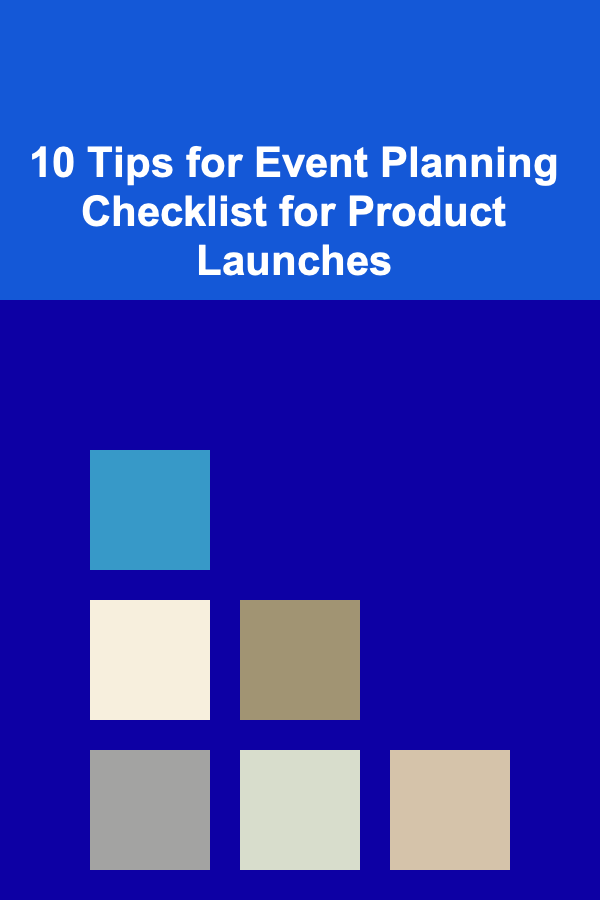
10 Tips for Event Planning Checklist for Product Launches
ebook include PDF & Audio bundle (Micro Guide)
$12.99$7.99
Limited Time Offer! Order within the next:

Launching a new product is an exciting time for any business, but it requires careful planning and coordination to ensure success. A well-executed product launch event can generate buzz, attract customers, and provide significant exposure. However, the process can be overwhelming without a solid plan. In this article, we'll cover 10 essential tips for creating an event planning checklist that will help ensure your product launch is smooth and effective.
Define Clear Objectives
Before diving into the logistics of the event, it's crucial to define clear and specific objectives. What are you hoping to achieve with the product launch? The purpose of the event will shape every aspect of your planning, from the venue and timing to the guest list and promotional activities.
Key Objectives to Consider:
- Brand Awareness: Do you want to introduce your brand to new audiences or reinforce your brand's message to existing customers?
- Sales and Lead Generation: Are you looking to generate immediate sales or gather leads for future conversion?
- Media Coverage: Do you want to attract media attention and have journalists attend the event?
- Customer Engagement: Are you planning to directly engage with your audience to create loyalty and advocacy for your product?
Once you have clear objectives, you'll be able to tailor every decision to meet those goals.
Develop a Timeline and Set Milestones
Timing is crucial when planning a product launch event. Start planning well in advance to give yourself ample time to manage all the necessary tasks and overcome any potential challenges. A detailed timeline will help ensure that everything is completed on time and nothing is overlooked.
How to Create a Timeline:
- Set a Launch Date: Determine when you want to officially launch your product.
- Break Down Tasks: Create a detailed checklist of tasks that need to be completed leading up to the launch, including venue selection, invitation sending, content creation, and more.
- Set Milestones: For each major task, set deadlines to keep you on track. This will help you gauge progress and avoid last-minute stress.
- Leave Time for Adjustments: Allow buffer time for unexpected challenges. It's always best to have extra time rather than rushing toward the final days.
By creating a timeline, you'll ensure all steps are completed in the proper order, allowing you to stay on track for a successful launch.
Select the Right Venue
The venue you choose for your product launch event will set the tone and atmosphere of the entire event. It's important to choose a location that aligns with your brand and product, and that can accommodate your expected guest list.
Factors to Consider When Choosing a Venue:
- Capacity: Ensure the venue can comfortably accommodate the number of guests you expect. If you're expecting a large crowd, opt for a larger venue.
- Location: Choose a venue that's easily accessible to your target audience, whether it's local or international. Consider transportation and parking options.
- Brand Fit: Select a venue that matches the image of your product. A luxury brand launch might benefit from a high-end venue, while a tech product could be better suited for a modern, sleek location.
- Ambiance: Think about the atmosphere you want to create. Lighting, sound, and décor can all be adjusted to fit the vibe you want.
Choosing the right venue is essential for creating the right impression and experience for your attendees.
Curate the Guest List
The success of your product launch event heavily depends on your guest list. You'll want to invite people who are important for the success of your product---this includes media personnel, industry influencers, potential customers, and business partners.
Types of Attendees to Include:
- Media and Journalists: Invite industry journalists, bloggers, and influencers who can help spread the word about your product.
- Target Customers: Consider inviting existing or potential customers who would be interested in your product.
- Key Partners and Investors: Your business partners, suppliers, and investors should be a priority to demonstrate the importance of their role in your product's success.
- Internal Team: Don't forget to invite your team members who have worked hard on the product development.
Make sure to send invitations in advance, and use personalized communication to ensure your guests feel valued.
Plan the Event Program and Activities
An engaging event program is key to keeping your attendees entertained and informed about your product. Plan activities that are interactive, informative, and aligned with your event's objectives.
Key Program Elements to Include:
- Product Presentation: This is the heart of your launch event. Plan a well-rehearsed presentation that highlights the features and benefits of your product. Keep it engaging and informative.
- Live Demonstrations: If possible, offer live demonstrations to show how your product works and its value. Allow attendees to experience it firsthand.
- Q&A Sessions: Give attendees an opportunity to ask questions about the product and its features.
- Networking Opportunities: Create opportunities for your guests to mingle and network. This can be done through designated networking times or casual meet-and-greet sessions.
- Entertainment: Depending on your brand, consider adding entertainment to the event, such as music, performances, or guest speakers.
The program should have a balanced mix of formal and informal elements to maintain audience interest and ensure your product takes center stage.
Coordinate Event Marketing and Promotion
To ensure your product launch event is a success, you'll need to effectively promote it before, during, and after the event. Event marketing helps generate excitement, encourage attendance, and create lasting buzz.
Promotional Strategies:
- Pre-event Marketing: Start promoting the event through email invitations, social media posts, and advertisements. Create a sense of anticipation by offering sneak peeks or exclusive previews.
- Media Coverage: Reach out to journalists and bloggers to cover the event and product launch. Prepare press releases and media kits to make it easy for media to report on your launch.
- Social Media: Use platforms like Instagram, Facebook, and Twitter to generate buzz about the event. Consider using a dedicated hashtag and encourage attendees to share their experiences on social media.
- Event Live Stream: For larger audiences, consider live-streaming the event to reach a broader demographic.
Effective marketing ensures that the event garners the attention it deserves, attracting the right audience and generating excitement around your product.
Secure the Right Event Vendors
Events often require various vendors to help bring your vision to life. From catering and audiovisual equipment to décor and event staff, you'll need to coordinate with different vendors to ensure everything runs smoothly.
Key Vendors to Consider:
- Catering: Choose a catering company that aligns with your event's tone and audience. Ensure the menu is suitable for all dietary restrictions.
- Audiovisual: Hire a professional AV team to manage the sound, lighting, and visual elements of your event. This includes microphones, projectors, and screens for presentations.
- Event Decor: Work with a designer or decorator to create a cohesive look for the event that aligns with your brand and product.
- Photographers and Videographers: Capture the moments of your event for future marketing materials and social media content.
Ensure that all vendors are briefed on your goals for the event, and work closely with them to ensure everything goes according to plan.
Prepare Event Materials and Giveaways
For a memorable product launch event, you'll want to prepare materials that provide value to your attendees. These materials should offer information about your product and reinforce your brand message.
Event Materials to Consider:
- Product Brochures: Prepare detailed product brochures or flyers that attendees can take home, which include product features, pricing, and purchasing information.
- Branded Merchandise: Offer branded giveaways, such as T-shirts, hats, or tote bags, that attendees can take home as a reminder of the event and product.
- Product Samples: If appropriate, offer samples of your product for attendees to try. This is especially useful for food, beauty, or tech products.
- Event Programs: Create a printed or digital event program that outlines the schedule and any important information for the day.
These materials can help attendees better understand your product and leave them with a lasting impression of your brand.
Monitor and Manage On-site Logistics
On the day of the event, it's crucial to stay organized and manage logistics efficiently. This includes coordinating with the venue, vendors, and staff to ensure everything runs smoothly.
Key Logistics to Manage:
- Registration and Check-in: Set up a smooth check-in process for your guests to avoid long lines and confusion.
- Signage and Directions: Make sure that guests know where to go by providing clear signage and directions within the venue.
- Staff Coordination: Brief your staff and volunteers on their roles for the day, including guiding guests, managing the schedule, and troubleshooting any issues.
- Technical Support: Have technical support available in case any issues arise with sound, lighting, or audiovisual equipment.
Being proactive about managing on-site logistics will help prevent issues and ensure that the event runs seamlessly.
Measure and Analyze Success
After the event, it's essential to assess the success of your product launch. Did you meet your objectives? What worked well, and what could be improved for next time?
How to Measure Success:
- Attendance and Engagement: Track how many people attended the event and engaged with your content or product.
- Sales and Leads: Measure how many sales or leads were generated as a result of the launch.
- Media Coverage: Evaluate how much media coverage your event received, including press mentions and social media posts.
- Feedback: Collect feedback from attendees to understand their experience and areas for improvement.
This analysis will give you valuable insights to refine your future product launches and events.
By following these 10 tips, you can ensure that your product launch event is well-planned, engaging, and impactful. Planning an event takes time and effort, but with the right approach, you can create a memorable experience that leaves a lasting impression on your customers and stakeholders.
Reading More From Our Other Websites
- [Skydiving Tip 101] Top & Features Every Modern Skydiving Helmet Should Have
- [Personal Care Tips 101] How to Care for New Mothers with Self-Care Tips and Essentials
- [Personal Investment 101] How to Use Investment Clubs to Enhance Your Knowledge
- [Home Security 101] How to Create a Home Security Plan for Every Room
- [Personal Financial Planning 101] How to Tackle Financial Planning for Late Starters with Limited Income
- [Home Cleaning 101] Best Cleaning Tools and Gadgets: Must-Haves for Every Home
- [Organization Tip 101] How to Rotate Crops to Maintain Soil Health
- [Rock Climbing Tip 101] Pioneers of the Crag: Legendary Climbers Who Shaped the Sport
- [Star Gazing Tip 101] Best Light‑Pollution Filters to Enhance Urban Star Gazing Experiences
- [Gardening 101] Garden Planning Made Easy: The Definitive 2025 Planting Calendar

How to Set Up an Indoor Family Obstacle Course
Read More
How to Store Emergency Kits for Easy Accessibility
Read More
How to Use Under-Bed Storage to Save Space
Read More
How To Work Remotely with Kids at Home
Read More
How To Encourage Positive Behavior with Gentle Discipline
Read More
10 Tips for Beginner Golfers: Avoiding Common Mistakes
Read MoreOther Products

How to Set Up an Indoor Family Obstacle Course
Read More
How to Store Emergency Kits for Easy Accessibility
Read More
How to Use Under-Bed Storage to Save Space
Read More
How To Work Remotely with Kids at Home
Read More
How To Encourage Positive Behavior with Gentle Discipline
Read More